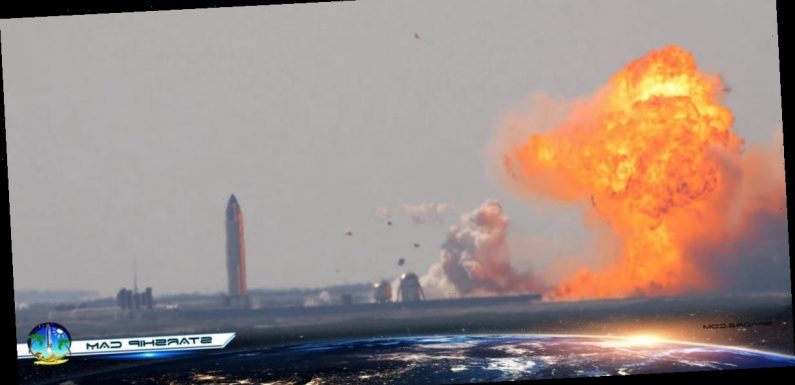
- SpaceX launched a 16-story prototype of its Starship Mars rocket system 10 kilometers (6.2 miles) above Boca Chica, Texas on Tuesday.
- The prototype, called SN9, was supposed to attempt a soft landing, but the spaceship slammed into the ground sideways and exploded.
- This is the second time the aerospace company, founded by Elon Musk, has launched such an ambitious Starship flight and seen the vehicle destroyed upon landing.
- Visit Business Insider’s homepage for more stories.
Through the south Texas haze on Tuesday, SpaceX pulled off a stunning high-altitude test flight of a Starship rocket prototype. However, the vehicle failed to stick a landing.
The launch of the roughly 16-story test vehicle, called Starship serial No. 9, met the same fate as its predecessor, SN8: it slammed into the landing pad, resulting in a catastrophic explosion.
SN9 lifted off a pad in Boca Chica, a remote strip of land in southeastern Texas, around 3:25 p.m. ET under the thrust of three truck-size Raptor rocket engines. The vehicle then soared to 6.2 miles (10 kilometers), gradually cutting its engines on the way up. Using just one engine, it hovered at the peak of its flight for about 30 seconds, then cut that engine and belly-flopped toward the ground — a test of Starship’s need to control its descent from space using small wings.
As SN9 fell back to Earth, the rocket reignited its engines in an attempt to quickly turn itself upright. But it appeared to lack enough thrust from at least one engine, causing the ship to tilt past upright, lean to its other side, and hit a concrete pad at an angle, exploding its remaining fuel reserves.
Chunks of the steel ship flew thousands of feet into nearby coastal prairie. When the dust and smoke cleared, all that was left were charred remains of SN9.
SPadre.com captured the incident from a camera on top of a building in South Padre Island, which is located about 9.5 kilometers (5.9 miles) away:
SpaceX also livestreamed the flight, and a camera near the landing pad recorded the descent from below and the explosion from a different angle:
“As you can see from the scene, we had — again — another great flight up to the 10-kilometer apogee,” John Insprucker, an aeronautical engineer at SpaceX, said during a live broadcast of the flight. “We’ve just got to work on that landing a little bit.”
Sticking the landing is a key part of SpaceX founder Elon Musk’s quest to realize Earth’s first fully and rapidly reusable rocket system. (You can’t reuse a rocket that gets severely damaged every time it launches and lands.)
SN9 represents only the upper stage of a two-part system; a roughly 23-story booster called Super Heavy is designed to one day heave the Starship spaceship toward orbit.
Eventually, Musk has said that the Starship-Super Heavy system could fly people to orbit, the moon, and Mars, where he hopes to establish the first human civilization on another planet.
However, the company must first figure out how to land the rocket back on Earth in one piece, then quickly recycle it for its next launch. So far, its two attempts at flying Starship prototypes to high altitudes have not been able to land without exploding. The company still claims them as successes, though, since they demonstrate that the rocket can fly to suborbital altitudes and use its wing flaps to control its plummet back towards Earth.
“This is a test flight, the second time we’ve flown Starship in this configuration. We’ve got a lot of good data in the primary objective: To demonstrate control of the vehicle in a subsonic reentry,” Insprucker said.
SpaceX also has to clear big regulatory hurdles before it can fly the full Starship-Super Heavy system toward orbit.
Starship’s road to orbit is paved with regulations
SpaceX first launched a Starship prototype of this kind in early December. Called Starship serial No. 8, or SN8, it roared tens of thousands of feet above the company’s south Texas facilities. As SN8 neared the ground, low pressure in a propellant tank caused the spaceship to slam into a concrete pad and explode.
It was not immediately clear on Tuesday afternoon if SN9 encountered a similar issue or if something entirely different caused its fiery demise.
SpaceX plans to conduct more suborbital test flights, including with SN10 — which sat on a launchpad next to SN9 — to further test, improve, and master its spaceflight systems. It’s unclear if the newer prototype was damaged by the shrapnel of its predecessor.
The eventual plan is to rocket a Starship into orbit and test its ability to reenter Earth’s atmosphere without breaking into pieces and burning up. Before SpaceX can attempt this, though, it needs to get an orbital-class launch license from the Federal Aviation Administration.
Obtaining such a license requires clearing many regulatory hurdles, the most laborious of which is called the National Environmental Policy Act. SpaceX previously completed an intense, nearly three-year environmental impact statement for Boca Chica launches in July 2014. But that plan described flights of Falcon 9 and Falcon Heavy rockets — not Starship-Super Heavy, which is several times larger than either existing vehicle.
The company is now waiting to start an environmental assessment process, or EA, which could take several months to complete. However, if it reveals “impacts that cannot be mitigated,” according to the FAA, SpaceX may need to conduct another impact statement, which can take an additional one to three years.
It was recently revealed SpaceX plans to dig natural-gas wells in Boca Chica — most of which is a nature preserve — to fuel both Starships and power plants.
Watch SpaceX’s SN9 flight broadcast
SpaceX livestreamed the flight attempt, which you can replay on YouTube.
https://www.youtube.com/embed/_zZ7fIkpBgs?start=306
Source: Read Full Article